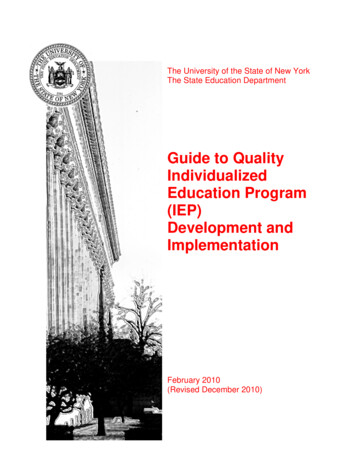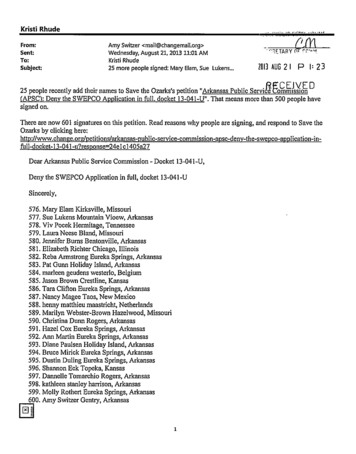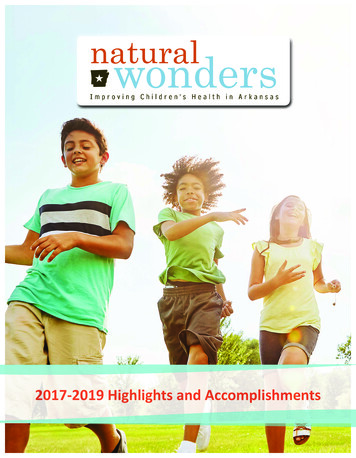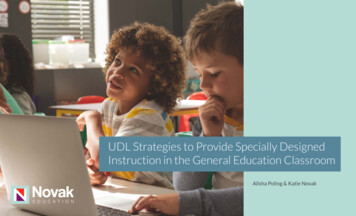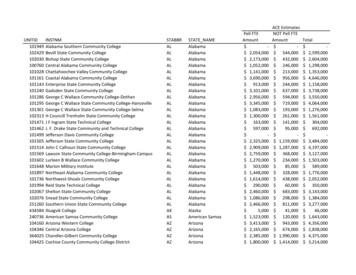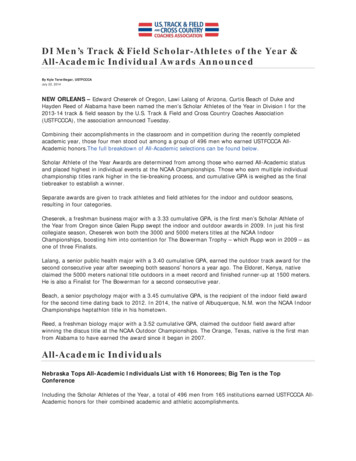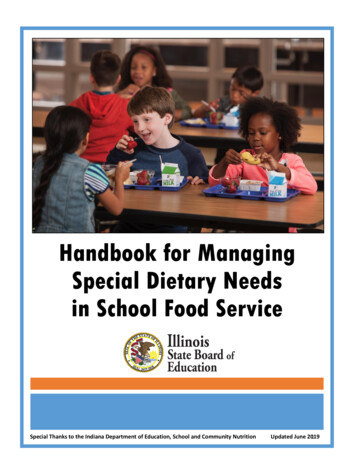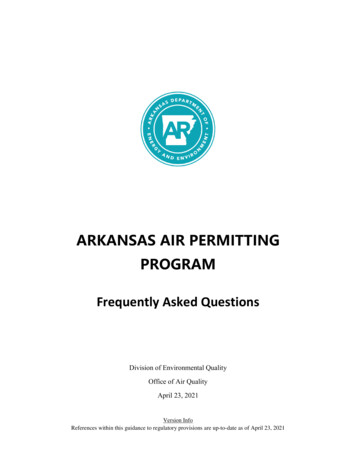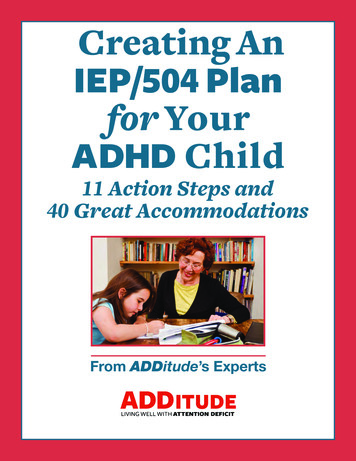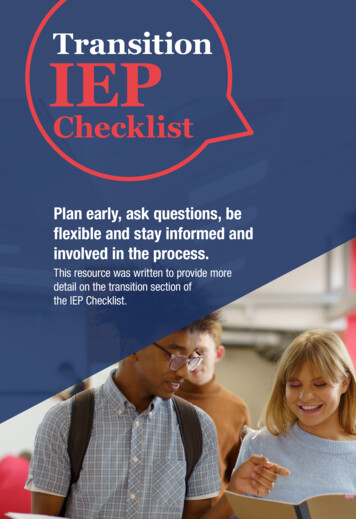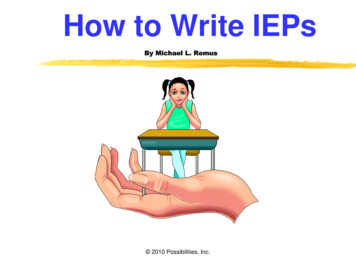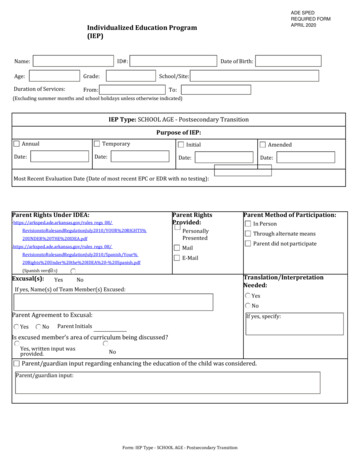
Transcription
ADE SPEDREQUIRED FORMAPRIL 2020Individualized Education Program(IEP)Name:ID#:Date of Birth:Age:Grade:School/Site:Duration of Services:From:To:(Excluding summer months and school holidays unless otherwise indicated)IEP Type: SCHOOL AGE - Postsecondary TransitionPurpose of te:Most Recent Evaluation Date (Date of most recent EPC or EDR with no testing):Parent Rights Under IDEA:Parent rules regs arkansas.gov/rules regs 20IDEA%20-%20Spanish.pdfParent Method of Participation:In PersonThrough alternate meansParent did not participateE-Mail(Spanish version)Excusal(s):YesNoIf yes, Name(s) of Team Member(s) nt Agreement to Excusal:YesNoIf yes, specify:Parent InitialsIs excused member's area of curriculum being discussed?Yes, written input wasprovided.NoParent/guardian input regarding enhancing the education of the child was considered.Parent/guardian input:Form: IEP Type - SCHOOL AGE - Postsecondary Transition
Name:Present Level of Academic Achievement and Functional PerformanceA statement of the child's present levels of academic achievement and functional performance including:- Child's strengths and needs (include data used to determine strengths and needs)- Consider the academic, developmental, and functional needs resulting from the child's disability, which mayrequire special education, related services, supplementary aids, supports for personnel, or modifications.- Consider how the child's strengths relate to the child's postsecondary goals.- Effect of the child's disability on his/her involvement in the general education curriculum- Consider how the child's disability will affect the child's ability to reach his/her postsecondary goals (what thechild will do after high school).- Achievement of annual goals, performance in related service areas, and a description of any significant lack of progress.Transfer of Rights: In Arkansas, beginning not later than one year before a child reaches the age of majority under Statelaw, age eighteen (18), except for a child with a disability who has been determined to be incompetent under state law, thechild's IEP must include a statement that the child has been informed of his or her rights under Part B of the Act, if any, thatwill transfer to the child on reaching the age of majority, consistent with 34 CFR 300.520 and §9.00 of these regulations.N/A for this IEPDate notification was given to the child and parent:Initial Date of Transition PlanDevelopment:Student's Disability:Dates Plan was Reviewed (must bereviewed at least annually):Post-Secondary Transition Goals and ServicesThese goals and services are to be in place beginning not later than the first IEP to be in effect when the child turns 16, or younger ifdetermined appropriate by the IEP Team, and are to be reviewed at least annually and revised as needed.List age appropriate transition assessments used annually in determining postsecondarygoals and include year administered. For each year, multiple assessments may be listed.ASSESSMENTForm: IEP Type - SCHOOL AGE - Postsecondary TransitionYear(s) Provided
Name:1) REQUIRED - Postsecondary Career/Employment Goal(s) (After high school, what kind of work will you do?):After high school(student's name/I) will:Transition Activities/Services that will help student move towardCareer/Employment Goal Indicated Above:Responsible Party's TitleSemester/Year to beImplemented (e.g., Fall/15)2) REQUIRED - Postsecondary Education/Training Goal(s) (After high school, what additional education and training will you receive? Thiseducation/training will be correlated to career/employment goals or independent living skill goals.):After high school(student's name/I) will:Transition Activities/Services that will help student move towardEducation/Training Goal Indicated Above:Responsible Party's TitleSemester/Year to beImplemented (e.g., Fall/15)3) Postsecondary Independent Living Skills (ILS)/Community Participation Goal(s): Before establishing a goal, make sure a variety of ILS areconsidered. Remember, the activities you include under the goal should be specific to supporting the student's moving toward living independently.After high school(student's name/I) will:Transition Activities/Services that will help student move towardIndependent Living Skills/Community Participation Goal IndicatedResponsible Party's TitleAbove:Semester/Year to beImplemented (e.g., Fall/15)If there are no areas of deficit, include a statement indicating the student will maintain his or her current skills (as indicated in assessment results)to live independently.Consider the need for outside agency participation, as well as the need to invite the agency to the IEP meeting. If agencies are providing services tostudents to promote movement toward goals, include those appropriate activities in the IEP.Form: IEP Type - SCHOOL AGE - Postsecondary Transition
Name:Courses of StudyBased on the current goals, provide specific and individualized course of study. Courses must reasonably enable the child to meethis/her postsecondary goals and be projected through their anticipated exit year. The description may be an individualized list ofcourses and/or a narrative focusing on specific skills/knowledge to be acquired in a class.Choose one option below:Narrative DescriptionList of Courses DescriptionList of Courses (Complete table below):SubjectSchool Year:School Year:School Year:School Year:EnglishSocial StudiesOral CommunicationsMathematicsSciencePhysical EducationHealth and SafetyEconomicsFine ArtsCareer FocusElectiveElectiveElectiveElectiveNarrative of Course Description:Summary of Performance is an additional piece mandated by IDEA but not part of the IEP. It must be completed during the final yearof the child's high school education and a copy given to the child.Form: IEP Type - SCHOOL AGE - Postsecondary Transition
Name:Consideration of Special FactorsCheck yes or no whether the IEP team considers each special factor to be relevant to this child.For factors checked yes, explain any services and supports that are needed in the IEP.YesIf yes, explainNoLanguage needs as related to the IEP for achild who is an English LearnerYesInstruction in Braille if the child is blind orvisually impaired, unless determinedinappropriate based on evaluationNoCommunication needs, and for the child whois deaf or hard of hearing, the language andcommunication needs and opportunities forcommunication and instruction in the child'snative language and communication modeYesIf yes, explainIf yes, explainNoYesIf yes, explainNoAssistive technology devices and servicesYesPositive behavioral interventions andsupports and other strategies to addressbehaviorSupplementary aids and services, programmodifications and accommodations, and/orsupports for personnel in general educationor other education-related settingsNoYesIf yes, explainNoYesAre there other factors that needconsideration?If yes, explainNoForm: IEP Type - SCHOOL AGE - Postsecondary TransitionIf yes, explain
Name:Extended School Year (ESY):ESY will be considered at a later date.ESY is not necessaryESY is necessary. (Document services below).GoalDescription ofServicesTime/AmountFrequencyLocationBegin DateEnd DateParticipation in Program Options, Nonacademic, and Extracurricular ActivitiesThe district assures that this child will have an equal opportunity to participate in program options, nonacademic and/orextracurricular activities and services offered by the district.Form: IEP Type - SCHOOL AGE - Postsecondary Transition
Name:IEP GoalsIEP Goals without ObjectivesIEP Goals with ObjectivesAnnual Goals: provide measurable annual goals, including academic and functional goals to enable the child to beinvolved in and make progress in the general education curriculum and to meet other educational needs that result fromthe disability.Goal #:Goal Area:Curriculum-Based AssessmentProgress towards the Goal will be measured by :Student ConferencesGradesPortfoliosChecklistsScoring RubricsTeacher/Text TestObservation ChartsWork SamplesOther (specify):Progress Reports Completed Each Grading/Progress Period, as Scheduled by the St.DateProgressSt.DateProgressSt.Key for Status of Goals C Continued D Discontinued M Mastered N Not InitiatedAnnual Goals: provide measurable annual goals, including academic and functional goals to enable the child to beinvolved in and make progress in the general education curriculum and to meet other educational needs that result fromthe disability.Goal #:Goal Area:Curriculum-Based AssessmentProgress towards the Goal will be measured by :Student ConferencesPortfoliosChecklistsGradesScoring RubricsTeacher/Text TestObservation ChartsWork SamplesOther (specify):Progress Reports Completed Each Grading/Progress Period, as Scheduled by the St.DateKey for Status of Goals C Continued D Discontinued M Mastered N Not InitiatedForm: IEP Type - SCHOOL AGE - Postsecondary TransitionProgressSt.DateProgressSt.
Name:IEP Goals with ObjectivesAnnual Goals: provide measurable annual goals, including academic and functional goals to enable the child to beinvolved in and make progress in the general education curriculum and to meet other educational needs that result fromthe disability.Goal #:Goal Area:Date Annual Goal Mastered:Objectives: Required for students who take alternate assessments; optional for all other students1.2.3.4.5.Curriculum-Based AssessmentProgress towards the Goal will be measured by :Student ConferencesGradesPortfoliosChecklistsScoring RubricsTeacher/Text TestObservation ChartsWork SamplesOther (specify):Goal mberObjective Progress ssSt.DateProgressSt.
Key for Status of Goals C Continued D Discontinued M Mastered N Not InitiatedForm: IEP Type - SCHOOL AGE - Postsecondary Transition
Name:Services(Schedule of Services)Special Education ServicesCo-taught services inIndirect Services inDirect instruction inSpeech/Language servicesinTime/AmountFrequencySettingNumber of1XDayRegular ClassroomMinutes:2XWeekSpecial Ed Classroom3XMonthTherapy Room4XQuarterOther o-taught services inIndirect Services inDirect instruction inSpeech/Language services inNumber of1XDayRegular ClassroomMinutes:2XWeekSpecial Ed Classroom3XMonthTherapy Room4XQuarterOther o-taught services inIndirect Services inDirect instruction inSpeech/Language services inNumber of1XDayRegular ClassroomMinutes:2XWeekSpecial Ed Classroom3XMonthTherapy Room4XQuarterOther o-taught services inIndirect Services inDirect instruction inSpeech/Language services inNumber of1XDayRegular ClassroomMinutes:2XWeekSpecial Ed Classroom3XMonthTherapy Room4XQuarterOther orm: IEP Type - SCHOOL AGE - Postsecondary Transition
Name:Services SummaryRelated ServicesNone NeededRelated Service(s):(Please type if a service is not listed)Time/AmountFrequencySettingNumber of1XDayRegular ClassroomMinutes:2XWeekSpecial Ed Classroom3XMonthTherapy Room4XQuarterOther (specify):Hours:Periods:5X6XSessions:7X8X9XRelated Service(s):(Please type if a service is not listed)Number of1XDayMinutes:2XWeek3XMonthRegular ClassroomSpecial EdClassroomTherapy Room4XQuarterOther (specify):Hours:Periods:5X6XSessions:7X8X9XRelated Service(s):(Please type if a service is not listed)Number of1XDayMinutes:2XWeek3XMonthRegular ClassroomSpecial EdClassroomTherapy Room4XQuarterOther (specify):Hours:Periods:5X6XSessions:7X8X9XForm: IEP Type - SCHOOL AGE - Postsecondary Transition
Name:Least Restrictive Environment ConsiderationsExtent of Participation in General EducationFor K-12: The general education environment includes all academic instruction as well as meals, recess, assemblies, field trips, etc.Will this child participate 100% of the time with non-disabled peers in the general education environment?YesNoIndicate the reasons why the IEP team determined that provision of services in the general education setting was not appropriate forthe child.The child's acquisition of academic/developmental skills cannot be addressed through modification/adaptation ofthe general curriculum.Small group instruction is necessary for the child to acquire skills specified in the IEP.Behavior intervention strategies established in the child's IEP require a degree of structure that cannot beimplemented in a large group setting.The child's needs cannot be achieved in the general education environment even when supplemental aids andsupports are provided.The child's behavior significantly impedes his or her learning and that of others.Additional individualized instruction is needed to facilitate learning.A more structured environment is needed than can be provided in the general education setting.Is this placement in the school the child would normally attend if nondisabled?If no, is the placement as close as possible to the child's home?YesYesNoNoIf no, explain why the IEP requires otherarrangements:The continuum of placements for the least restrictive environment (LRE) includes regular classes with indirect service (RG), regularclass 80% or more (RG), regular class 40% to 79% (RR), regular class less than 40% (SC), School-based Day Treatment, Special DaySchool, Residential School, Hospital Program, and Homebound Instruction.Continuum ofPlacement:Regular Class with Indirect Service (RG)Regular Class 80% or more (RG)Regular Class 40% to 79% (RR)Regular Class Less Than 40% (SC)School-based Day TreatmentSpecial Day SchoolResidential SchoolHospital ProgramHomebound InstructionCorrectional FacilityAmount of time IN general education setting:% of time per weekForm: IEP Type - SCHOOL AGE - Postsecondary Transition
Name:Assessment Decision1. Can the child participate in regular statewide and districtwide required assessments?YesNoA. List accommodations needed (if any) consistent with IEP and general test administration guidelines.None neededAccommodations needed:2.If the child will participate in the Arkansas Alternate Assessment Program, has the IEP team considered the guidelines forparticipation in alternate assessment?YesNoA. If the child will participate in the Arkansas Alternate Assessment Program, provide a statement of why the childcannot participate in regular assessment.I understand that my child will be assessed with the statewide alternative assessment based on alternate achievement standards.Parent Signature:essment in 10th grade.Form: IEP Type - SCHOOL AGE - Postsecondary Transition
Name:Alternate English Language Proficiency Assessment (Alt ELPA) DecisionComplete this section ONLY if the student is an English Learner.The child does not have the most significant cognitive disability. If the child doesnot have the most significant cognitivedisability, do NOT complete the remaining portion of this Alt ELPA section.K-2: The child will be in K-2 for the next administration of the English LanguageProficiency Assessment (usually late Februarythrough early April) AND the child meets the criteria as being a child with the mostsignificant cognitive disability.3-10: The child will be in grade 3-10 for the next administration of the EnglishLanguage Proficiency Assessment (usually lateFebruary through early April) AND the child meets the criteria for and participates in thestate’s alternate assessment.11-12: The child will be in grade 11 or 12 for the next administration of the EnglishLanguage Proficiency Assessment(usually late February through early April) AND the child meets the criteria for andparticipated in the state’s alternate assessment in 10th grade.Form: IEP Type - SCHOOL AGE - Postsecondary Transition
Name:Alternate Pathway to GraduationNot Applicable: Student does not meet the criteria as having the most significant cognitive disability and/or the student will not beentering a grade level listed below. If NA, do not complete the remaining portion pertaining to the Alternative Pathway toGraduation.Please complete the following for students with the most significant cognitive disabilities who will be in the grades indicated below:2019-20 Ninth graders2020-21 Ninth and tenth graders2021-22 Ninth, tenth, and eleventh graders2022-23 All high school studentsBeginning with the 2019-20 school year, IEP teams must determine whether a student with the most significant cognitive disabilityshould follow the general pathway to graduation or the alternate pathway to graduation. The alternate pathway is only available tostudents with the most significant cognitive disabilities who participate in the alternate assessment in high school.My child will participate in the alternate pathway to graduation and the high school transcript will indicate this pathway. (Courses onthis alternate pathway will not transfer to the general pathway.)My child will participate in the general pathway to graduation.My child will work toward a certificate (e.g. Certificate of Attendance or Certificate of IEP Goals being met), not a standard diploma.Projected Graduation Year:Parent/Guardian Signature:Student Signature:(Student signature required if student has reached the age of majority and parent has not obtained guardianship)Form: IEP Type - SCHOOL AGE - Postsecondary Transition
Name:Parent(s) received Parent Survey:YesNoN/AParent was provided a copy of the IEP:In PersonBy MailE-mailTeam Participant SignaturesParent(s)Special Education TeacherGeneral Education TeacherLocal Education Agency RepresentativeIndividual to Interpret Instructional Implications ofEvaluation ResultsStudentOther :Form: IEP Type - SCHOOL AGE - Postsecondary Transition
his/her postsecondary goals and be projected through their anticipated exit year. The description may be an individualized list of courses and/or a narrative focusing on specific skills/knowledge to be acquired in a class. Choose one option below: Narrative Description List of Courses Description List of Courses (Complete table below):
